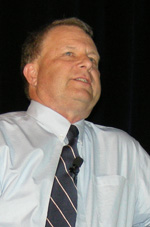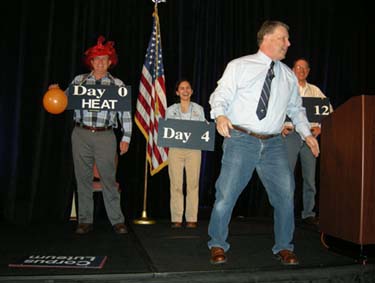NAAB Symposium
Understanding the Estrous Cycle
“The most important thing beef producers can learn is how the estrous cycle works,” says Bill Beal, professor of animal science at Virginia Polytechnic Institute and State University. Beal spoke April 30 in Sacramento, Calif. at the NAAB Symposium, which preceded the 2009 Beef Improvement Federation (BIF) Conference.

Bill Beal, Virginia Tech
The estrous cycle starts on Day 0 when a large follicle on the ovary creates the hormonal push necessary to initiate estrus, or heat. The follicle produces estrogen, which causes cows to exhibit “estrous behavior” such as bellowing, secreting cervical mucus and standing to be mounted, Beal explained. Typically estrus lasts for 12 hours.
On Day 1, about 30 hours after estrus began, the cow ovulates, releasing an egg into the oviduct where it will wait to be fertilized. Estrogen levels then drop, decreasing the hormonal drive for displaying standing estrous behavior. The corpus luteum (CL) then begins to grow on the ovary in the place vacated during ovulation by the follicle. The CL releases progesterone, the hormone which prevents the female from returning to heat and signals to the uterus to prepare for a fertilized egg, he explained.
By Day 12 the CL has grown to its maximum diameter. If fertilization occurs and a viable embryo is present in the uterus by Day 18, the CL is maintained and continues producing large amounts of progesterone, which prevents the return of estrus. However, Beal said that if fertilization does not occur and the uterus fails to detect a growing embryo it will produce prostaglandin, destroying the CL and triggering the development of another follicle. The cow would then enter standing heat again, completing the 21-day cycle.
“Now that we understand how the estrous cycle works, we can begin to determine the best time to breed cows to maximize pregnancies,” Beal said. Standard practice is to inseminate 12 hours after the onset of estrus, though many studies throughout the past 60-plus years have questioned whether this is best. Some have concluded it’s best to inseminate closer to the onset of estrus because it yields higher embryo quality, though it comes at the cost of lower fertilization rates. Still others have determined that insemination closer to ovulation is best since it yields higher fertilization rates, though lower embryo quality can be a problem.
“These conflicting conclusions indicate that the window of opportunity for timing AI may be longer than commonly believed,” Beal said. “You can still get acceptable results even without optimum timing.”

Beal used a live demonstration including audience members to explain the estrous cycle of the cow.
Editor’s Note: This summary was written under contract or by staff of Angus Productions Inc. (API). To request reprint rights contact Shauna Rose Hermel, editor, at 816-383-5270. PowerPoints are posted with permission of the presenter and may not be reproduced in whole or in part without the express permission of the presenter.
The 41st BIF Research Symposium and Annual Meeting was hosted by the California Beef Cattle Improvement Association and the California Cattlemen's Association. For more information, visit www.bifconference.com or www.calcattlemen.org/bif2009.html.



